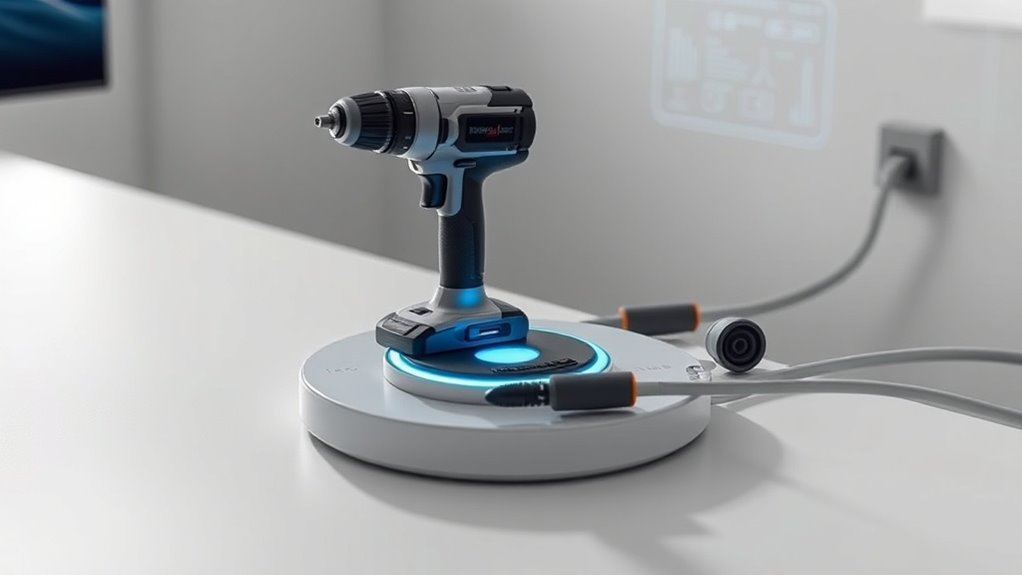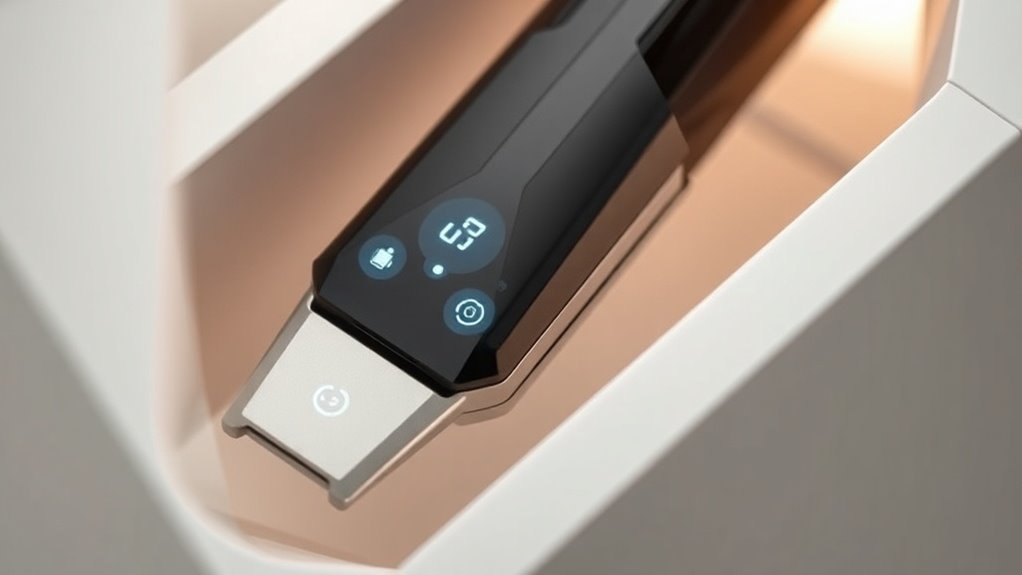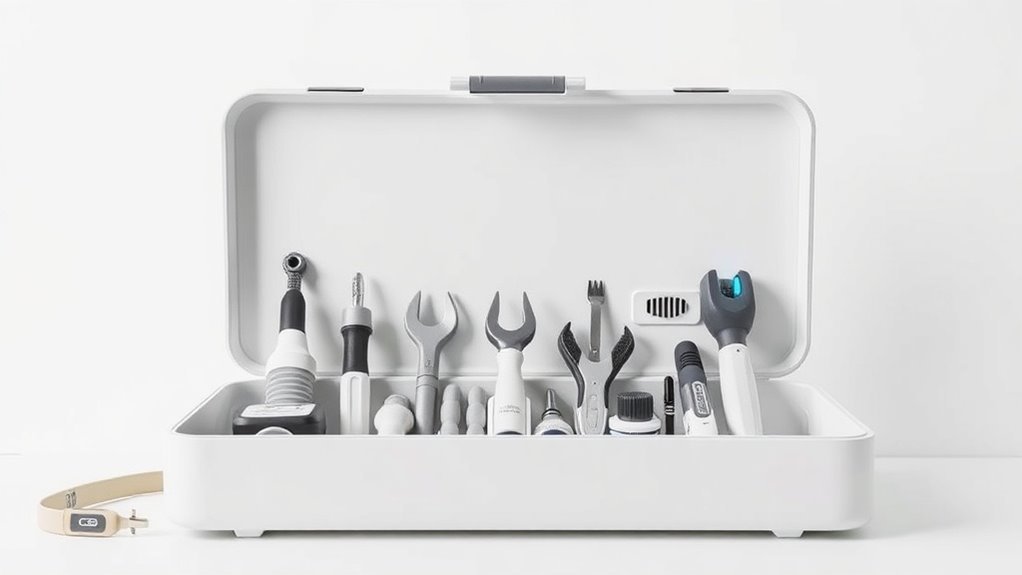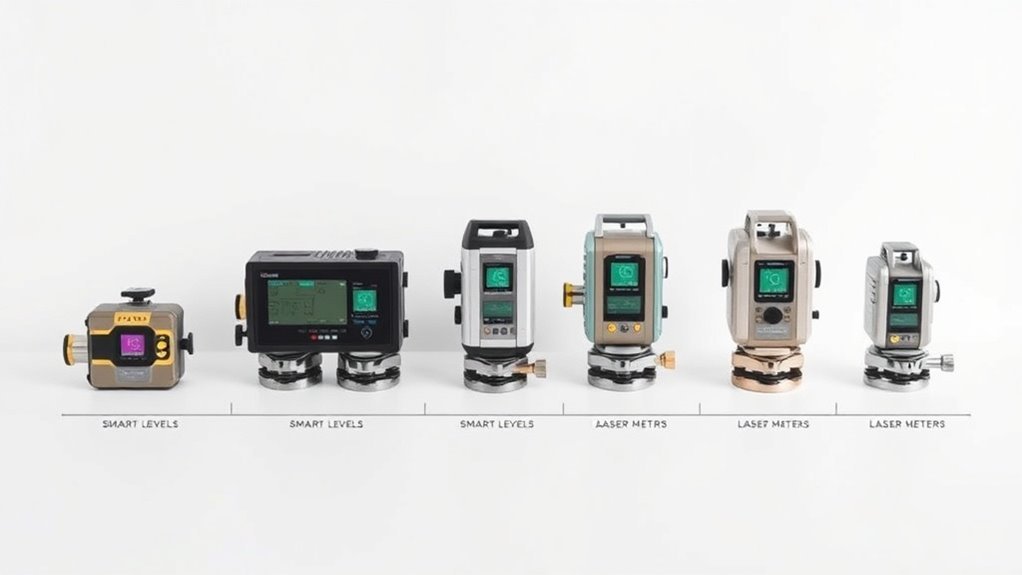Wireless Charging in Smart Tool Systems

Wireless charging is revolutionizing smart tool systems by offering convenience and eliminating pesky cords. This technology uses electromagnetic induction to transfer energy, allowing you to charge devices effortlessly. With benefits like reduced wear on batteries and a streamlined user experience, it enhances productivity by enabling tools to operate while charging. Despite some challenges, future trends promise faster speeds and improved efficiency. Discover how these advancements can elevate your smart tools even further.
Key Takeaways
- Wireless charging technology utilizes electromagnetic induction, enabling the transfer of energy without the need for physical connectors.
- The convenience of wireless charging eliminates the hassle of cable management, enhancing portability for smart tool users.
- Reduced wear and tear on devices leads to improved battery longevity and reliability, as frequent plugging and unplugging is avoided.
- Future advancements in wireless charging promise faster speeds and greater efficiency, potentially integrating into furniture and public spaces for seamless use.
- User experience design must focus on intuitive interfaces and accessibility to enhance usability, especially for users with impairments.
The Rise of Wireless Charging Technology
As technology evolves, you might’ve noticed the surge in wireless charging options across various devices. This shift isn’t just a trend; it represents a fundamental change in how we power our gadgets.
From smartphones to electric toothbrushes, more products are embracing this convenience, taking advantage of electromagnetic fields to charge without cords. The rise of wireless charging is driven by the demand for ease and efficiency, making it easier for you to keep your devices topped up.
With innovations like Qi charging standards and fast-charging capabilities, you’re witnessing a broader adoption in personal and professional tools. This technology is transforming our interaction with devices, paving the way for a future where charging could become entirely seamless and integrated into our everyday environments.
Benefits of Wireless Charging in Smart Tools

With wireless charging in smart tools, you get enhanced convenience and portability that makes your work easier.
You’ll also notice less wear and tear on your devices, leading to longer lifespans.
Plus, improved safety standards mean you can focus on your tasks without worrying about tangled cords or electrical hazards.
Enhanced Convenience and Portability
Wireless charging greatly enhances the convenience and portability of smart tools, making them more user-friendly than ever. You won’t have to fuss with tangled cables or search for outlets, allowing you to focus on your tasks. This technology promotes an easier way to keep your tools powered up, wherever you are. Imagine spending less time setting up and more time getting things done.
Here’s a quick comparison of wireless charging benefits:
| Feature | With Wireless Charging | Without Wireless Charging |
|---|---|---|
| Cable Management | Minimal | High |
| Portability | High | Low |
| Setup Time | Instant | Time-consuming |
| User Experience | Streamlined | Frustrating |
| Compatibility | High | Varies |
Embrace the freedom of wireless charging!
Reduced Wear and Tear
When you consider the long-term maintenance of your smart tools, opting for wireless charging can greatly reduce wear and tear on both the devices and their battery life.
Traditional charging methods often involve frequent plugging and unplugging, which can wear down charging ports and leads to physical damage over time.
With wireless charging, there’s no need for connectors that can degrade with use. This means your tools remain intact and functional for longer periods.
Additionally, wireless charging tends to generate less heat, further protecting the battery from stress and prolonging its lifespan.
Improved Safety Standards
One of the standout advantages of using wireless charging in smart tool systems is the enhanced safety it offers. Unlike traditional charging methods that can pose risks of electrical shocks or shorts, wireless charging minimizes these hazards.
Here are a few reasons why you’ll appreciate this improved safety:
- No exposed connections: Eliminating contact points reduces the chances of accidental shocks.
- Overheat protection: Many wireless chargers have built-in mechanisms to prevent overheating, adding an extra layer of safety to your tools.
- Durability: With fewer physical connections to wear out or break, your tools are more reliable and less likely to fail during use.
Embracing wireless charging not only boosts convenience but also helps guarantee that you’re working in a safer environment.
How Wireless Charging Works

Wireless charging relies on electromagnetic induction, where energy transfers from a charging pad to your smart tool.
You’ll find that a few key components, like coils and a power source, play essential roles in this process.
However, it’s important to take into account efficiency and compatibility issues that might affect your charging experience.
Electromagnetic Induction Principles
Although the concept of wireless charging might seem modern, it relies on the well-established principles of electromagnetic induction. This occurs when an electric current passes through a coil, generating a magnetic field.
When another coil, placed within that magnetic field, receives the magnetic energy, it’s converted back into electricity to charge your device.
Here are some key points to remember about electromagnetic induction:
- Coils: At least two coils are involved; one generates a magnetic field, while the other captures it.
- Magnetic Field: This invisible field enables power transfer without direct contact.
- Efficiency: Wireless charging is efficient but can lose some energy as heat, making positioning essential for peak performance.
Understanding these basics helps you appreciate how convenient wireless charging can be!
Charging Pad Components
The heart of a charging pad lies in its carefully designed components that work together to harness electromagnetic induction. When you place your smart tool on the pad, energy flows through copper coils, generating a magnetic field. This field interacts with the receiver coil in your device, transferring energy efficiently.
Here’s a quick look at the essential components:
| Component | Function |
|---|---|
| Transmitter Coil | Emits electromagnetic field |
| Receiver Coil | Captures energy and converts it to charge |
| Control Circuit | Manages power flow and safety protocols |
| Housing Material | Protects components and enhances durability |
Understanding these components helps you appreciate the seamless experience of wireless charging. Your gadgets get energy without the hassle of cables!
Efficiency and Compatibility Issues
Charging pads are impressive in their design, but their effectiveness can be influenced by several factors.
When you use a wireless charger, efficiency can drop due to misalignment or external interference. To guarantee ideal performance, keep these points in mind:
- Device compatibility: Not all devices support wireless charging, so check your tool’s specs.
- Obstacles: Any object between the charger and the device can hinder energy transfer, so remove cases or metal objects.
- Distance: The further away your tool is from the charging pad, the less efficient it becomes, so aim for a snug fit.
Popular Smart Tools Featuring Wireless Charging
As technology evolves, more smart tools are incorporating wireless charging capabilities, making it easier than ever for you to keep your devices powered up. Here are some popular tools featuring this technology:
| Tool | Wireless Charging Feature |
|---|---|
| Smart Screwdriver | Charges on inductive pad |
| Cordless Drill | Compatible with Qi chargers |
| Laser Level | Integrated wireless charging |
| Smart Measuring Tape | Auto-rechargeable technology |
| Bluetooth Speaker | Wireless charging dock |
These tools not only boost convenience but also reduce the clutter of cables in your workspace. By using devices with wireless charging, you’re embracing a more efficient and streamlined approach to your tasks. This integration of Bluetooth and app features allows users to enhance productivity while charging their devices seamlessly. Explore these tools to add versatility to your smart toolkit!
The Impact on Productivity and Efficiency
Incorporating wireless charging into smart tools greatly enhances productivity and efficiency. You no longer have to waste time searching for charging cables or waiting for devices to juice up. Instead, you can focus on what really matters: getting the job done.
- Seamless integration: Wireless charging eliminates the need for physical connections, allowing you to power up with minimal interruption.
- Continuous operation: Smart tools can remain in use while charging, ensuring that workflows aren’t disrupted.
- Reduced downtime: With less time devoted to plugging and unplugging, you can allocate more energy to your tasks, keeping you on schedule.
Overcoming Challenges in Wireless Charging Implementation
While the benefits of wireless charging in smart tools are clear, overcoming the challenges associated with its implementation is essential for widespread adoption.
One major hurdle you might face is guaranteeing compatibility with existing devices. Not all tools are designed for wireless charging, so you’ll need to evaluate specifications carefully.
In addition, efficiency can be an issue; slower charging times compared to traditional methods may frustrate users. Additionally, you’ll have to take into account safety standards and guarantee that charge transfer doesn’t generate excessive heat.
Finally, cost can’t be ignored—implementing wireless charging technology can be pricey, impacting your budget. Addressing these factors will help streamline your shift, making wireless charging a reliable choice for smart systems.
Future Trends in Wireless Charging for Smart Systems
With advancements in technology accelerating, the future of wireless charging in smart systems looks promising. You can expect several exciting trends shaping the way we power our devices:
- Higher Efficiency: Innovations will lead to faster charging speeds, making downtime a thing of the past.
- Increased Range: Future systems may allow users to charge devices from a distance, eliminating the need for precise placement.
- Integration with Smart Environments: Wireless charging may become embedded in furniture and public spaces, creating a seamless charging experience.
As these trends unfold, you’ll see smart tools evolving, offering you more convenience in every aspect of your life.
Embracing these changes can lead to smarter living and more efficient use of energy. Isn’t that something to look forward to?
Comparing Wireless Charging to Traditional Methods
As the promising trends in wireless charging evolve, it’s important to contemplate how this technology stacks up against traditional charging methods.
Traditional charging, often involving cables and plugs, can be cumbersome and prone to wear. You might find yourself wrestling with tangled cords or dealing with frayed connections.
In contrast, wireless charging offers convenience—just place your device on a pad or dock, and you’re good to go. However, it typically has slower charging speeds and can be less efficient, especially at greater distances.
That said, the ergonomics of wireless solutions might outweigh the minor drawbacks, as they eliminate the hassle of cords and enhance the overall experience in smart tool use.
Ultimately, the choice hinges on your specific needs and context.
User Experience and Accessibility in Smart Tool Design
Designing smart tools goes beyond just innovative technology; it also prioritizes user experience and accessibility. You want tools that not only perform well but are easy for everyone to use. Here are some key factors to evaluate:
Smart tools should combine cutting-edge technology with user-friendly designs for enhanced accessibility and a better overall experience.
- Intuitive Interfaces: Tools should have simple controls and options to minimize frustration. You shouldn’t need a manual to figure them out.
- Ergonomic Design: Comfort matters. Tools should fit well in your hand, reducing strain during extended use.
- Visual and Auditory Cues: Incorporating clear signals, like lights or sounds, helps guide you during use, especially for those with hearing or vision impairments.
Additionally, focusing on ergonomic features like weight distribution can enhance overall comfort and prevent fatigue during prolonged work sessions.
When smart tools are user-friendly and accessible, they truly enhance your work experience, making it more efficient and enjoyable.
Questions
What Are the Safety Concerns With Wireless Charging Technology?
Wireless charging technology can pose safety concerns like overheating, electromagnetic interference, and the potential for damage to devices if not properly designed. You’ll want to guarantee compatibility and follow manufacturer guidelines to minimize risks.
Can All Devices Support Wireless Charging?
Not all devices support wireless charging. You’ll need to check your device’s specifications for compatibility. Many smartphones and some wearables do, but others, like older gadgets, typically require a wired connection instead.
How Do Environmental Factors Affect Wireless Charging Efficiency?
Environmental factors like temperature, humidity, and interference from other devices can greatly affect charging efficiency. You’ll notice that ideal conditions lead to faster charging, while adverse ones slow it down, impacting your device’s performance.
What Is the Cost Comparison Between Wireless and Traditional Charging?
When comparing costs, wireless charging tends to be higher initially due to technology and infrastructure. However, considering convenience and long-term use, you might find it’s worth the investment over traditional charging methods.
Are There Specific Maintenance Tips for Wireless Chargers?
To maintain your wireless charger, keep it clean and dust-free, avoid exposing it to extreme temperatures, and use only recommended power sources. Regularly check for wear on charging pads and cables to guarantee peak performance.
Conclusion
As you explore the world of wireless charging in smart tool systems, you can’t help but wonder—what’s next? The benefits are clear, promising enhanced productivity and efficiency. But what challenges lie ahead? The technology is evolving, and with it, the potential for groundbreaking innovations. Imagine a future where your tools are always powered and ready to go, without the hassle of cords. Are you ready to embrace this new era of convenience, or will you cling to the old ways?






